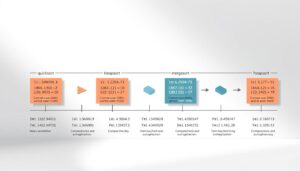Sorting algorithms differ in speed by a huge amount. Take bubble sort and quick sort, for example. When handling big data, the time saved can be massive. Sorting methods are key in computer science. They play a huge role in how data is sorted and found. This article will dive into the ten main sorting algorithms. We’ll look at their complexities and how they work. Knowing about these algorithms helps manage data better and making software run smoothly.
Key Takeaways

- The performance of sorting algorithms can vary dramatically depending on their complexity.
- Understanding sorting methods is vital for efficient data organization.
- Algorithm complexity influences software performance significantly.
- Efficient sorting techniques enhance user experience in applications.
- Mastering sorting algorithms is needed for effective data management.
- An optimized data structure is as import as the algorithm itself
What is a Sorting Algorithm?
A sorting algorithm is a method used to order data in a certain way, either from smallest to largest or the opposite. They are very important in technology because they help organize and access data better. This basic understanding lets us see how sorting algorithms work and why they are used in many areas. They are key in making information clearer and search processes quicker. By sorting data well, it becomes simpler to look through and study.
Sorting algorithms are extremely important in technology: they are used in managing databases, improving searches, and in the field of data science. Good sorting makes software run faster by making it easier to find and work with data. It leads to better experiences for users.
Benefits of Efficient Sorting Algorithms
Sorting algorithms boost computing performance significantly. They make managing data much easier by being more efficient. When data is sorted well, finding what you need is quicker. This makes data easier to use.
- Improved data accessibility: efficient sorting means obviously that data is organized better = it can be found faster. This is key in databases and apps where speed matters. Faster search times let companies answer questions quickly. This boosts their operations.
- Enhanced performance for other algorithms: sorting doesn’t just speed up finding data. It also helps other algorithms work better. Algorithms for searching or merging work faster with sorted data. This way, sorting benefits many kinds of computing tasks. It increases the efficiency of an application or system.

Applications of Sorting Algorithms
In databases today, sorting is crucial for keeping records neat. It’s about lining up entries by date, name, or numbers. Good sorting lets us find info fast, making the database work better. Techniques like quick sort and merge sort are popular. They’re great with big data sets.
Real-world Coding
Sorting matters a lot in software engineering. A very detailed programming course on sorting algorithms:
The Two Primary Categories of Sorting Algorithms
Sorting algorithms are key in computer science. They come in two main kinds: comparison-based and non-comparison-based. Each kind has its own way of dealing with data and performance goals.
- Comparison-based sorting algorithms: algorithms that sort by comparing elements are called comparison-based. Quick Sort and Merge Sort are well-known examples. They arrange data by comparing elements. These methods work with many data types. But they might slow down with big data sets. Knowing their time complexity is crucial.
- Non-comparison-based sorting algorithms: non-comparison-based algorithms don’t rely on comparing elements. They use data properties instead. Counting Sort and Radix Sort are examples. They use things like the number range to sort. These methods are fast in certain situations, like with big or specific datasets.

Differences Between In-Place and Not-In-Place Sorting
Understanding in-place versus not-in-place sorting is key for optimizing algorithms. Each type uses memory differently, affecting efficiency. In-place sorting rearranges data within the same structure, using minimal memory. This is very useful when memory is limited.
Memory Usage Considerations In-place sorting uses a small, constant amount of memory, leading to better memory efficiency. Quick Sort and Heap Sort are examples that adjust data right in the array, avoiding the need for extra storage. In contrast, not-in-place sorting, like Merge Sort, requires more memory, which grows with the input size. This can be a downside when saving memory is important. | Performance Implications The way a sorting algorithm uses memory can greatly affect its speed. In-place sorting is often quicker because it doesn’t need extra space or to copy memory as much. Not-in-place sorting might be easier to use but can be slower due to the extra memory work. Knowing this helps developers pick the best sorting method for their project needs. |
The Main Sorting Algorithms
In the world of sorting data, there are many ways to organize information. It’s important to know the types of sorting algorithms. This helps people who work with data choose the best method for their needs, further to the comparison-based and non-comparison-based algorithms and the in-place versus not-in place reviewed above.
Criteria for Choosing Sorting Algorithms
 When picking a sorting algorithm, certain factors are key. These include:
When picking a sorting algorithm, certain factors are key. These include:
- Data size: big datasets work better with efficient algorithms. Smaller ones can handle simpler methods.
- Data structure: how data is organized affects which algorithm works best.
- Performance requirements: the need for speed can make some algorithms stand out more for certain tasks.
- Code maintenability and evolutions
Bubble Sort: A Detailed Review
 Bubble Sort is known for being simple and easy to use. This review looks at the good and bad sides of Bubble Sort. It explains how it works and when it’s efficient.
Bubble Sort is known for being simple and easy to use. This review looks at the good and bad sides of Bubble Sort. It explains how it works and when it’s efficient.
Bubble Sort principle: Bubble Sort is a straightforward sorting algorithm that organizes a list by repeatedly comparing and swapping adjacent elements if they are in the wrong order. Starting from the beginning of the list, it compares the first two elements; if the first is greater than the second, they are swapped. This process continues for each pair of adjacent elements until the end of the list is reached, ensuring that the largest element has “bubbled” to its correct position at the end. The algorithm then repeats this process for the remaining unsorted portion of the list, progressively moving smaller elements into their correct positions. This continues until no more swaps are needed, indicating that the list is fully sorted. While simple, Bubble Sort has a time complexity of O(n²), making it inefficient for large datasets.
Bubble Sort’s strengths
|
You have read 32% of the article. The rest is for our community. Already a member? Log in
(and also to protect our original content from scraping bots)
Innovation.world community
Login or Register (100% free)
View the rest of this article and all members-only content and tools.
Only real engineers, manufacturers, designers, marketers professionals.
No bot, no hater, no spammer.
FAQ
Why are sorting algorithms important in computing?
A sorting algorithm arranges data in order, either up or down. This makes finding and handling big data sets easier.. This is key for efficient searching and using data in things like databases and search engines. Popular sorting methods include Bubble Sort and Quick Sort. Other examples are Merge Sort and Radix Sort.
What are the main categories of sorting algorithms?
Sorting algorithms fall into two groups. There are ones based on comparisons, like Quick Sort. And ones not based on comparisons, like Counting Sort.
How do in-place and not-in-place sorting algorithms differ?
In-place algorithms rearrange data without extra space. Not-in-place ones need more memory, making them different in how much space they use.
What role do sorting algorithms play in data structures?
Sorting algorithms better organize data in structures. This makes finding and getting to data faster, boosting software. Developers pick sorting methods based on data size and needs. They think about time, space, and the job at hand to choose wisely.
External Links on Sorting Algorithms
International Standards
(hover the link to see our description of the content)
Glossary of Terms Used
User experience (UX): the overall satisfaction and perception of a user when interacting with a product, system, or service, encompassing usability, accessibility, design, and emotional response throughout the entire interaction process.



























Isnt quicksorts worst case scenario inefficient for large datasets? Cant radix sort be a better alternative sometimes?
Isnt it strange how we obsess over sorting algorithms, yet in real-world coding, we rarely implement them from scratch?
Interesting read! But do you think that bubble sort is still relevant in the real-world coding scenario nowadays?
Interesting read! But arent we oversimplifying by only counting six main algorithms? There are others worth exploring too, right?
Isnt it odd how bubble sort, despite its inefficiency, is still widely taught and used in coding tutorials?
Related Posts
Workstation Ergonomic Assessment
Engineering Change Order (ECO): Best Practices to Minimize Disruption and Cost
From Lab To Market: The Role of the Pilot Production Run
45+ More Cognitive Science Tricks for Games and Marketing: Psychological and Engagement
45+ Cognitive Science Tricks for Games and Marketing: Psychological and Engagement
Latest Publications & Patents on Zeolites